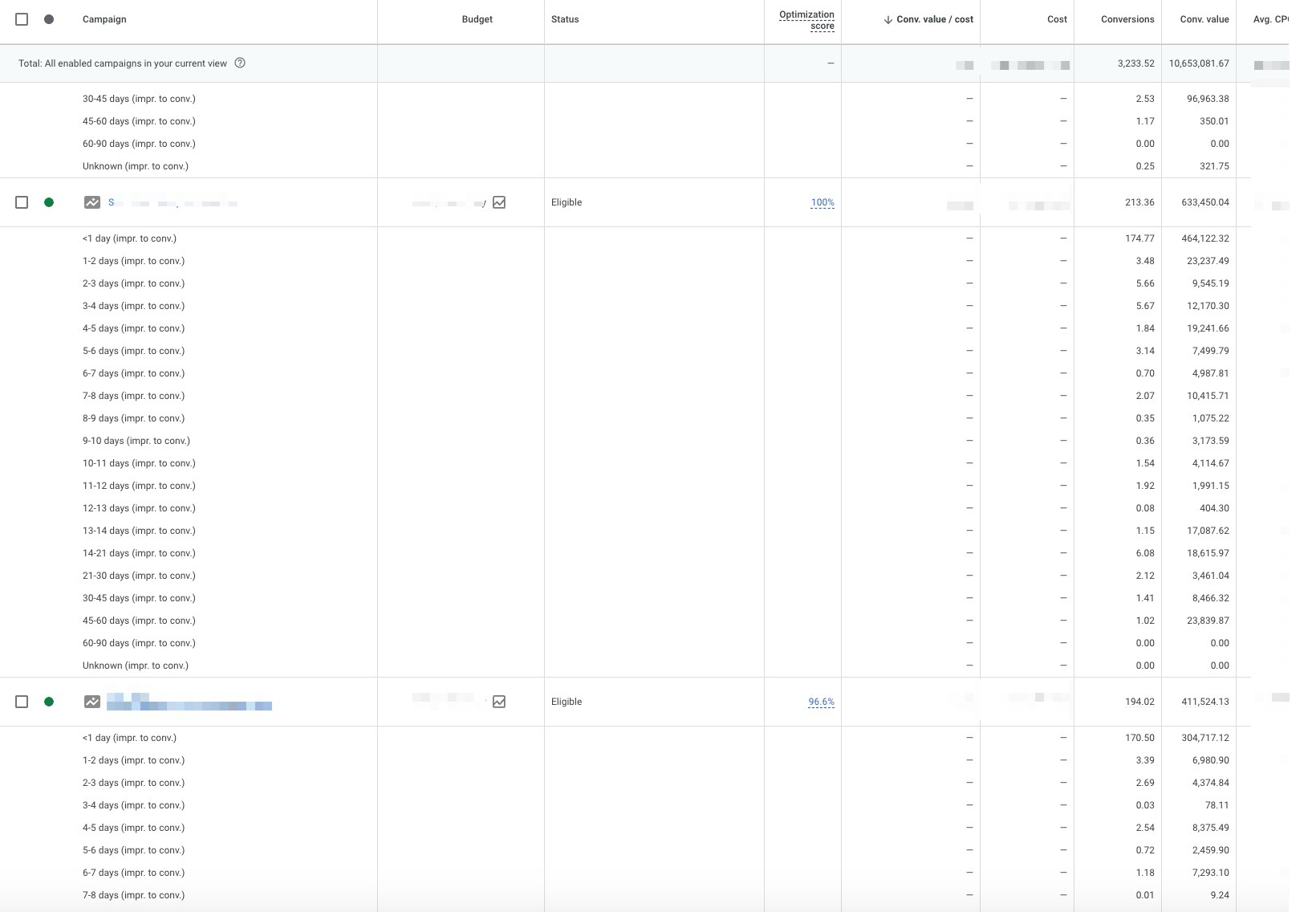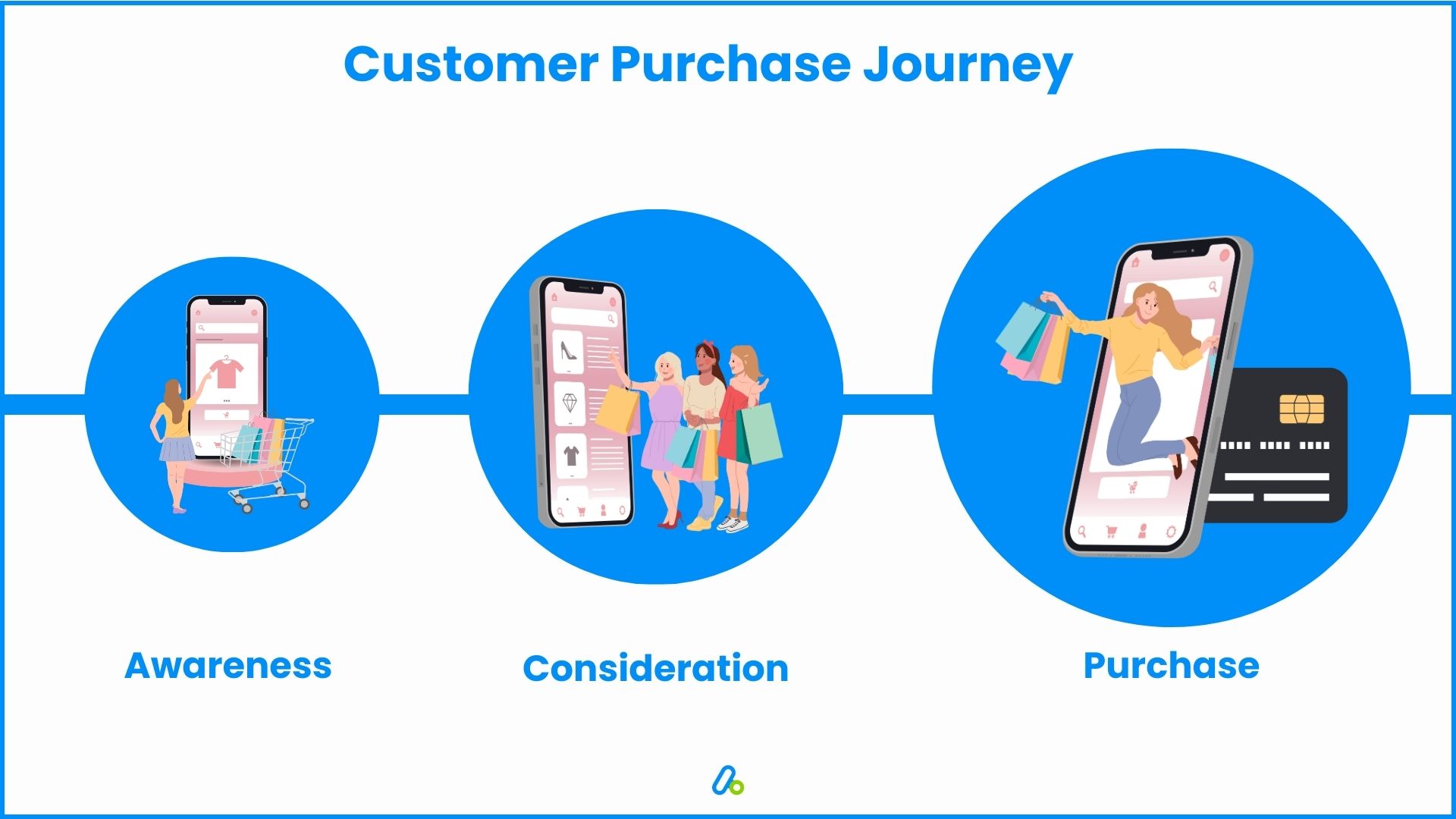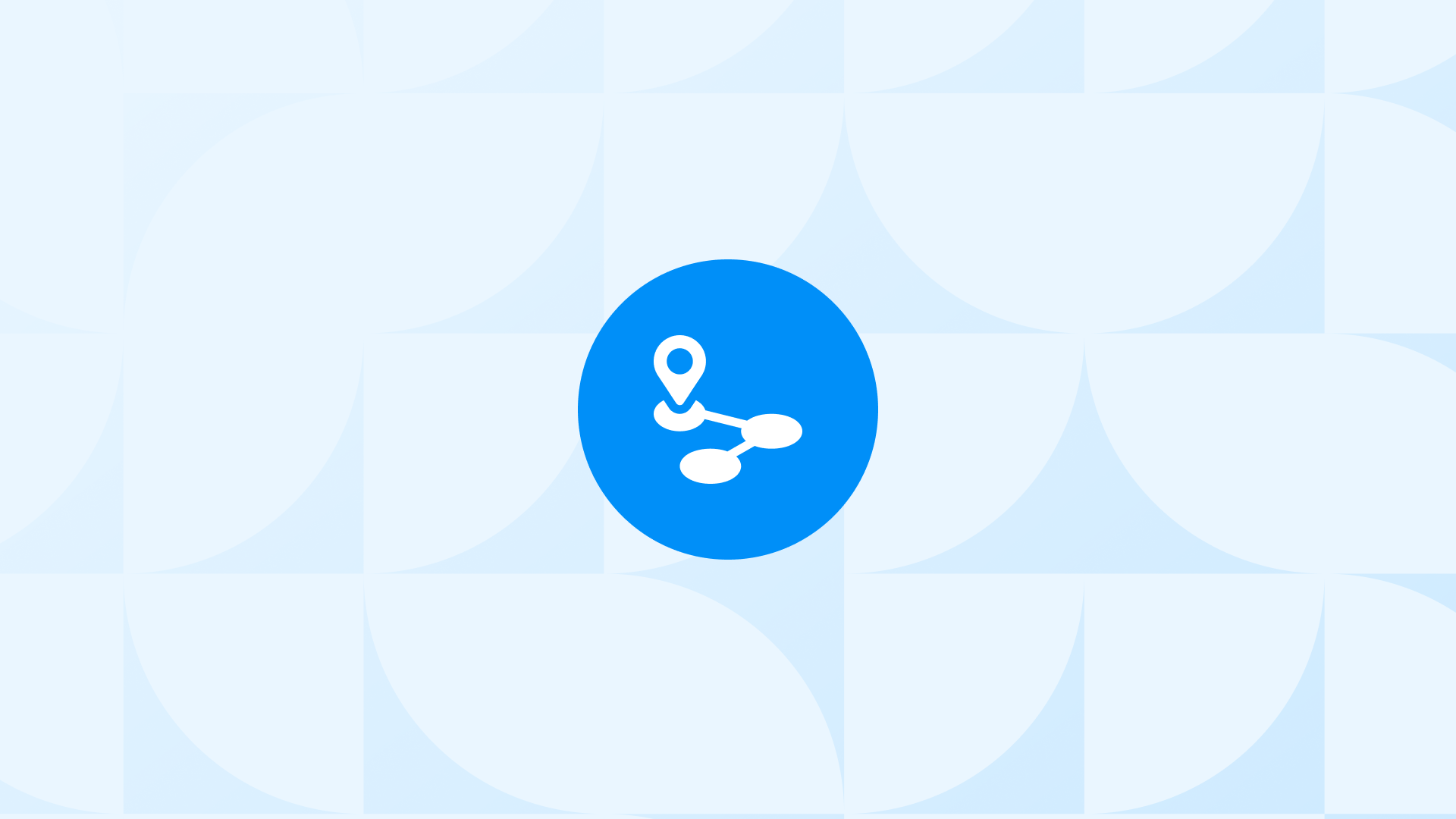If you analyze customer purchase journey with Google Ads, you can get important insights such as this:
The customer purchase journey isn’t always linear.
Someone who clicks on your ad might be initially interested but needs time to research further, compare options, or discuss the purchase with others.
However, they might also convert right away.
You should know how long it takes users to convert after clicking your ad so you can set your remarketing & promotional campaigns accordingly.

Here, you will learn:
- Segmenting your conversion data to analyze customer purchase journey with Google Ads,
- What journey customers go through during the purchasing process and what you can do,
- The importance of understanding the customer purchase journey,
along with many other valuable insights that can help you turn your potential customers into converters.
BEFORE YOU START: Explore our curated list of the best Shopify Google Ads apps to improve the performance of your Google Ads campaigns.
First Step to Analyze Customer Purchase Journey with Google Ads
To analyze customer purchase journey with Google Ads, you need to start by segmenting your conversion data.
Here’s a step-by-step guide that helps you segment conversion data by conversion and adjustment days:
Segmenting Conversion Data to Analyze Customer Purchase Journey
Here’s an example to better understand the importance of segmenting your conversion data to analyze customer purchase journey with Google Ads:
Let’s say you create ads for your high-end Shopify store that sells electronics, focusing on selling premium headphones.
Your target audience generally takes time to make a purchase decision because of the high price point and the availability of various options.
Campaign Setup
You’ve set up various ad campaigns targeting different keywords related to high-end headphones.
Your ads lead users to a landing page showcasing your best-selling headphones, along with reviews, comparisons, and detailed product information.
Initial Observation
Initially, you notice that the conversion rate directly from clicks within a day is relatively low. This could easily lead to the misconception that your ads are not performing well.
Segmenting Conversion Data
You want to analyze customer purchase journey with Google Ads, and you segment your conversion data by conversion and adjustment days.
You make a crucial discovery: A significant number of users who clicked on your ads convert after 14 days.
Some conversions are adjusted even after that, attributing to late conversion tracking or adjustment in conversion attribution.
Analysis
Long Consideration Phase: The segmented data reveals that your target audience spends a considerable amount of time researching and comparing before making a purchase. This long consideration phase is common for high-priced items, where buyers want to ensure they are making the right choice.
Adjustment Days Insight: Further analysis shows that conversions adjusted after the initial 14-day window often correlate with your retargeting campaigns and email marketing efforts. This suggests that these channels play a crucial role in nudging potential customers towards making a purchase.
Importance of Segmenting Data: Segmenting conversion data by conversion and adjustment days to analyze customer purchase journey with Google Ads allows you to accurately measure the effectiveness of your ad campaigns over time, rather than just the immediate aftermath of ad clicks. It highlights the need for a long-term strategy in high-value item marketing.
Armed with this insight, you decide to:
Enhance your retargeting campaigns, focusing on users who have interacted with your ads but haven’t converted within the first two weeks.
Develop a series of informative and persuasive email marketing campaigns aimed at educating your audience about the benefits of premium headphones over time, keeping your products top of mind.
Adjust your bidding strategy to focus not only on immediate conversions but also on capturing leads that convert over a longer period, ensuring you’re investing in users who are more likely to convert, even if it takes longer.
By segmenting conversion data by conversion and adjustment days, you gain valuable insights into the customer purchase journey, allowing for more informed decision-making and strategy optimization.
This approach helps you analyze customer purchase journey with Google Ads, highlighting the importance of a holistic view of customer behavior and the effectiveness of cross-channel marketing efforts in driving long-term conversions.
🎉 BONUS: You can improve your conversion tracking by setting up Google Ads Enhanced Conversion tracking.
Customer Purchase Journey Explained
It is essential to fully understand the customer purchase journey so you can measure all contributing factors of your marketing campaigns accurately.
This way, you can attribute the right value to the factors and get a good roadmap to make the necessary adjustments in your marketing budget distribution.

The customer purchase journey, often referred to as the buyer’s journey, is the process by which a potential customer becomes aware of, considers, and decides to purchase a new product or service.
Understanding this helps tailor your marketing strategies and ads to guide potential customers from discovery to purchase. The journey can be segmented into several key stages:
1. Awareness Stage
This is the initial stage where customers become aware of your business, product, or service.
They may discover you through various channels such as advertising, word-of-mouth, search engines, or social media.
In the context of Google Ads, targeting keywords related to the problem or need can help your product or service appear as a potential solution.
2. Consideration Stage
Once customers are aware of your business, they often engage in research to gather more information about your offerings.
They compare alternatives, read reviews, visit your website, and seek recommendations.
At this stage, your Google Ads should focus on providing helpful information, comparisons, and evidence of your product’s value, positioning it as the best solution to their problem.
3. Decision Stage
The decision stage is when the customer is ready to make a purchase but might be deciding between a few final options.
Here, the focus of your Google Ads could shift towards offering incentives, showcasing unique selling propositions, and providing strong calls to action to encourage the final purchase.
Post-Purchase
Though not always included in the purchase journey, the post-purchase evaluation is crucial for securing future loyalty and advocacy.
Customers assess whether the product or service met their expectations and decide if they would repurchase or recommend it.
If you can ensure a good post-purchase experience, it can lead to positive reviews and word-of-mouth recommendations, which are invaluable for attracting new customers.
🎉 BONUS: Boost your Shopify store’s sales with the best Shopify apps for after-purchase and upsell strategies.
Importance of Understanding the Customer Purchase Journey
The importance of understanding the customer purchase journey is non-negotiable for Shopify merchants and marketers utilizing Google Ads.
Once you analyze customer purchase journey with Google Ads, you can create targeted ads that meet the potential customers at each stage with the right message, increasing the likelihood of conversion.
By analyzing how customers move through the stages and adjusting your strategies accordingly, you can effectively guide them towards choosing your product or service over competitors.
Moreover, segmenting conversion data by conversion and adjustment days, as discussed in previous sections, plays a vital role in understanding this journey.
It helps identify at which stage of the purchase journey your marketing efforts are most effective and where there might be room for improvement.
For example, if you notice a longer time frame between awareness and consideration, you might need to adjust your ads to better educate and engage your potential customers during this phase.
By aligning your Google Ads campaigns with the stages of this journey and utilizing data segmentation, you can more effectively influence customer decisions, leading to better conversions and ROI.\n\n
Conclusion: Analyze Customer Purchase Journey with Google Ads Now
The power of Google Ads lies not just in its vast reach but in its ability to target and influence potential customers at every stage of their purchase journey.
As already explained, from the initial awareness stage to the post-purchase evaluation, each step of the customer purchase journey offers unique opportunities for engagement and conversion.
By segmenting conversion data by conversion and adjustment days, you can gain invaluable insights into how long it takes for a customer to convert.
This segmentation gives you a deeper understanding of the effectiveness of different marketing strategies across the journey’s various stages.
It highlights the importance of patience and precision in nurturing potential customers, ensuring that your marketing efforts are aligned with their readiness to buy.
In addition, tailoring your campaigns to meet the specific needs and behaviors of potential customers at each stage ensures that your marketing messages are relevant, timely, and persuasive.
As the digital landscape continues to evolve, so too will the ways in which customers navigate their purchase journeys.
Staying ahead means continually refining your approach, staying data-driven, and always being willing to adjust your strategies based on what the data tells you.
🎉 FINAL BONUS: You can explore key strategies to enhance each part of the customer journey by reading our comprehensive guide.

































